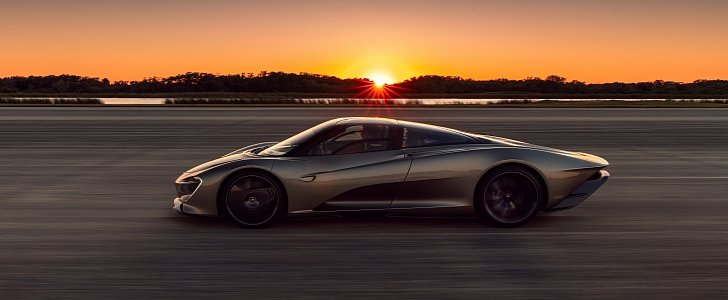Remember the PP2 pre-production prototype spied by the carparazzi not that long ago? McLaren has gifted that car a brother in the guise of the XP2 experimental prototype seen in the photo gallery, which has been proven to 250 miles per hour (403 km/h) at the Kennedy Space Center in Florida.
We had no questions in regard to how fast the Speedtail is when driven on a long-enough stretch of tarmac, but the funny thing about the high-speed validation program is that McLaren hasn’t designed the Speedtail to be road legal in the United States. In other words, the hyper-GT with seating for three adults can be driven only if you abide by the Show or Display rule that became law in August 1999.
Managed by the National Highway Traffic Safety Administration, the Show or Display’s requirements can be summed up as 2,500 miles annually. That’s the most you’ll be able to drive the Speedtail every year, and as a side note, you’ll be able to clock in that mileage in 10 hours of driving as long as you keep it steady at 250 mph.
“It’s fitting that the Speedtail’s high-speed test program concluded with multiple maximum-speed runs at a location strongly associated with pushing the boundaries of extreme performance and engineering excellence,” declared Mike Flewitt, the chief executive officer of McLaren. So how did the British automaker achieve this kind of velocity?
First things first, check out the design of the rear wheels and the pop-out video cameras that replace conventional side mirrors. The 5.2-meter length is augmented by super-slippery design even where you can’t see it, including areas such as the flat underfloor.
Staying true to the principles of the F1 from the 1990s, the Speedtail leverages on McLaren’s most modern technologies to improve the recipe with a parallel hybrid system featuring an electric motor. The Toyota Prius, by comparison, is a series-parallel hybrid thanks to the power-split device connecting the internal combustion engine, electric motor, and generator into a single unit.
The Speedtail, by comparison, sends the engine’s resources to the rear axle with the help of a seven-speed DCT while the electric motor acts on the input shaft of the Graziano-developed transmission. Unlike the P1, the Speedtail can't be driven in EV-only mode because of how the e-motor is directly connected to the DCT.
Managed by the National Highway Traffic Safety Administration, the Show or Display’s requirements can be summed up as 2,500 miles annually. That’s the most you’ll be able to drive the Speedtail every year, and as a side note, you’ll be able to clock in that mileage in 10 hours of driving as long as you keep it steady at 250 mph.
“It’s fitting that the Speedtail’s high-speed test program concluded with multiple maximum-speed runs at a location strongly associated with pushing the boundaries of extreme performance and engineering excellence,” declared Mike Flewitt, the chief executive officer of McLaren. So how did the British automaker achieve this kind of velocity?
First things first, check out the design of the rear wheels and the pop-out video cameras that replace conventional side mirrors. The 5.2-meter length is augmented by super-slippery design even where you can’t see it, including areas such as the flat underfloor.
Staying true to the principles of the F1 from the 1990s, the Speedtail leverages on McLaren’s most modern technologies to improve the recipe with a parallel hybrid system featuring an electric motor. The Toyota Prius, by comparison, is a series-parallel hybrid thanks to the power-split device connecting the internal combustion engine, electric motor, and generator into a single unit.
The Speedtail, by comparison, sends the engine’s resources to the rear axle with the help of a seven-speed DCT while the electric motor acts on the input shaft of the Graziano-developed transmission. Unlike the P1, the Speedtail can't be driven in EV-only mode because of how the e-motor is directly connected to the DCT.


















